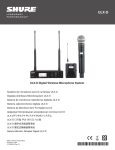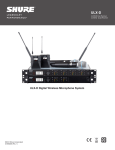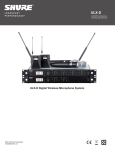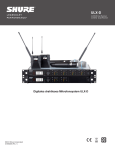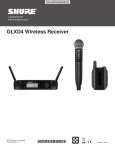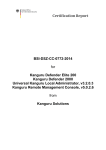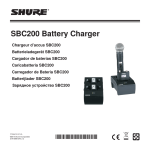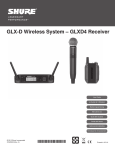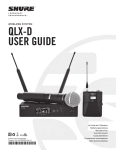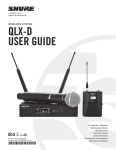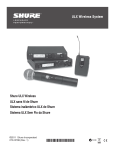Download Shure ULX Wireless System Specifications
Transcript
ULX-D ULX-D Digital Wireless Microphone System ©2011 Shure Incorporated 27A16234 (Rev. 1) 27A16234 ii IMPORTANT SAFETY INSTRUCTIONS 1. 2. 3. 4. 5. 6. 7. 8. 9. 10. 11. 12. 13. READtheseinstructions. KEEPtheseinstructions. HEEDallwarnings. FOLLOWallinstructions. DONOTusethisapparatusnearwater. CLEANONLYwithdrycloth. DONOTblockanyventilationopenings.Installinaccordancewiththemanufacturer’s instructions. DONOTinstallnearanyheatsourcessuchasradiators,heatregisters,stoves,orother apparatus(includingamplifiers)thatproduceheat. DONOTdefeatthesafetypurposeofthepolarizedorgroundingtypeplug.Apolarized plughastwobladeswithonewiderthantheother.Agroundingtypeplughastwoblades andathirdgroundingprong.Thewiderbladeorthethirdprongareprovidedforyour safety.Iftheprovidedplugdoesnotfitintoyouroutlet,consultanelectricianforreplacementoftheobsoleteoutlet. PROTECTthepowercordfrombeingwalkedonorpinched,particularlyatplugs,conveniencereceptacles,andthepointwheretheyexitfromtheapparatus. ONLYUSEattachments/accessoriesspecifiedbythemanufacturer. USEonlywithacart,stand,tripod,bracket,ortablespecifiedbythemanufacturer,orsoldwiththeapparatus.Whenacartisused,usecautionwhen movingthecart/apparatuscombinationtoavoidinjuryfromtip-over. UNPLUGthisapparatusduringlightningstormsorwhenunusedforlong periodsoftime. 14. REFERallservicingtoqualifiedservicepersonnel.Servicingisrequiredwhentheapparatushasbeendamagedinanyway,suchaspowersupplycordorplugisdamaged, liquidhasbeenspilledorobjectshavefallenintotheapparatus,theapparatushasbeen exposedtorainormoisture,doesnotoperatenormally,orhasbeendropped. 15. DONOTexposetheapparatustodrippingandsplashing.DONOTputobjectsfilledwith liquids,suchasvases,ontheapparatus. 16. TheMAINSplugoranappliancecouplershallremainreadilyoperable. 17. TheairbornenoiseoftheApparatusdoesnotexceed70dB(A). 18. ApparatuswithCLASSIconstructionshallbeconnectedtoaMAINSsocketoutletwitha protectiveearthingconnection. 19. Toreducetheriskoffireorelectricshock,donotexposethisapparatustorainor moisture. 20. Donotattempttomodifythisproduct.Doingsocouldresultinpersonalinjuryand/or productfailure. Thissymbolindicatesthatdangerousvoltageconstitutingariskof electricshockispresentwithinthisunit. Thissymbolindicatesthatthereareimportantoperatingandmaintenanceinstructionsintheliteratureaccompanyingthisunit. WARNING: ThisproductcontainsachemicalknowntotheStateofCaliforniatocause cancerandbirthdefectsorotherreproductiveharm. iii iv 중요 안전 지침 1. 2. 3. 4. 5. 6. 7. 8. 이지침을정독해주십시오. 이지침을잘보관해주십시오. 모든경고를유의하십시오. 모든지침을준수하십시오. 이기기를물가까이에두고사용하지마십시오. 마른수건으로만닦으십시오. 통풍구를막지마십시오.제조업체의지침에따라설치하십시오. 난방기,방열조절기,스토브,기타열을발산하는기기(앰프포함)근처에설 치하지마십시오. 9. 안전을위해유극또는접지타입의플러그를반드시사용하십시오.유극유형 의플러그에는폭이다른핀이있습니다.접지형플러그에는두개의핀과하 나의접지단자가있습니다.넓은핀이나접지단자는사용자의안전을위한 것입니다.제공된플러그가콘센트에맞지않으면전기기사에게문의하여구 형콘센트를교체하십시오. 10.전원코드는밟히지않도록주의하고특히전원플러그사이,접속소켓및기 기에서나오는부분에전원코드가끼이않도록보호하십시오. 11.제조업체가지정한부속품/부품만사용하십시오. 12.제조업체에서지정하거나기기와함께판매되는카트,스탠드,받 침대,브라켓또는테이블에서만사용하십시오.카트를사용하는 경우,이동시카트와기기가넘어져부상을입지않도록주의하 십시오. 13.낙뢰시또는장기간동안사용하지않을때는기기의전원을빼놓으십시오. 14.모든서비스는자격을갖춘서비스전문가에게의뢰하십시오.전원코드나플 러그가손상된경우,기기안으로액체를들어가거나물건을떨어뜨린경우, 기기가비나물에젖은경우,기기가정상적으로작동하지않는경우또는기 기를떨어뜨린경우와같이기기가손상되었을때는서비스를받아야합니다. 15.기기에물을떨어뜨리거나뿌리지마십시오.물병과같이물이담긴물체를기 기위에올려놓지마십시오. 16.MAINS플러그나기기용커플러는작동가능한상태로남아있어야합니다. 17.AC어댑터의공기매개잡음은70dB을초과하지않아야합니다. 18.CLASSI구조의기기는MAINS소켓콘센트에보호접지연결방식으로연결 되어야합니다. 19.화재나감전위험을줄이려면이기기를빗물또는습기에노출시키지마십 시오. 20.이제품을고치려고시도하지마십시오.그렇게하면사람이다치거나제품이 고장을일으킬수있습니다. 이기호는기기에전기쇼크위험을유발하는위험한전압이 흐른다는것을의미합니다. 이기호는이기기와함께제공된문서에중요한작동및유지 보수지침의내용이들어있다는것을의미합니다. v vi vii General Description Shure ULX-D Digital Wireless offers uncompromising audio quality and RF performance, with intelligent, encryption-enabled hardware and advanced rechargeability options for professional sound reinforcement. A breakthrough in wireless audio quality, Shure digital processing enables ULX-D to deliver the purest reproduction of source material ever available in a wireless system. Extended 20 Hz – 20 KHz frequency range and totally flat response captures every detail with clarity, presence, and incredibly accurate lowend and transient response. At greater than 120 dB, ULX-D delivers wide dynamic range for excellent signal-to-noise performance. For added convenience, proprietary Shure Gain Ranging optimizes the system’s dynamic range for any input source, eliminating the need for transmitter gain adjustments. In RF performance, ULX-D sets the bar for wireless channel efficiency and signal stability. Minimized intermodulation allows more transmitters to operate simultaneously over one TV channel than any other system. Rock-solid RF signal with no audio artifacts extends over the entire 100 meter line-of-sight range, even using standard dipole antennas. For applications where secure transmission is required, ULX-D offers Advanced Encryption Standard (AES) 256-bit encrypted signal for unbreachable privacy. Advanced Lithium-ion rechargeability provides extended transmitter battery life over alkaline batteries, battery life metering in hours and minutes accurate to within 15 minutes, and detailed tracking of battery health status. Generations ahead of any other available system in its class, ULX-D brings a new level of performance to professional sound reinforcement. Features Uncompromising Professional Digital Wireless • 24-bit/48 KHz digital audio that exceeds all other systems in accurate reproduction of the source material • 20 Hz – 20 KHz frequency range with flat response • Greater than 120 dB dynamic range for excellent signal-to-noise performance • Encryption-enabled for any application where secure transmission is needed: • Advanced Encryption Standard (AES-256) conforming to the US Government National Institute of Standards and Technology (NIST) publication FIPS-197 • Enabled via front panel menu and IR sync • Added benefit of eliminating stray RF interference by allowing only encrypted signal through to the receiver • Wide selection of trusted Shure Microphones Rugged, Intelligent Hardware • Optimized scanning automatically finds and deploys the cleanest frequencies available • Proprietary Shure Gain Ranging optimizes the system’s dynamic range for any input source, eliminating the need for transmitter gain adjustments • Up to 60 dB of adjustable system gain is easily accessible from the receiver front panel • Networkable receiver simplifies setup across multiple channels • AMX/Crestron control-compatible • Rugged metal housing on both transmitters and receiver • Interference detection and alerts provide instant confirmation when interference is present • Upgraded LCD screens with adjustable contrast and brightness on both transmitters and receivers Extremely Efficient and Reliable RF Performance Advanced Rechargeability - SB900 Shure Rechargeable Battery • Minimized intermodulation distortion results in significantly more channels on air, setting the bar for wireless performance in crowded RF environments • Provides ULX-D transmitters with greater than 12 hours of continuous use • Up to 64 MHz overall tuning range (region dependent) • 14 active transmitters in one 6 MHz TV channel • 17 active transmitters in one 8 MHz TV channel • Over 60 compatible channels on one frequency band • Rock-solid signal stability with no audio artifacts extends over the entire 100 meter line-of-sight range using standard supplied dipole antennas • Lithium-Ion chemistry and intelligent Shure battery circuitry results in rechargeable batteries with no memory effect. The battery can be recharged at any time; a complete discharge is never necessary • Transmitters and receivers display remaining battery life in hours and minutes accurate to within 15 minutes • The SBC200 Dual Docking Charger recharges batteries while in transmitters or out • Up to four SBC200s can be linked together to provide docked charging of eight transmitters from one power supply • The SBC800 Eight-Bay Charger brings up to eight SB900 batteries to full charge within three hours and 50% charge in one hour, with charge status LEDs for each battery • AA alkaline backwards compatibility • Both chargers fit in a standard-size rack drawer for easy transport and storage 1 Quickstart Instructions 1 2 a a b control 45° 12V OUT 150 mA line mic 15V 0.6A antenna . B power mic / line inst / aux control power SCAN SCAN sync push SCAN push push power www.shure.com EXIT power mic / line inst / aux line mic antenna . A power mic / line inst / aux ULXD4 push !! ! G:01 CH:21 485.775 MHz Rssi: -118 dBm EXIT www.shure.com ULXD4 www.shure.com 12V OUT 150 mA 15V 0.6A antenna . B 12V OUT 150 mA antenna . B line mic power 15V 0.6A power line mic mic / line mic / line control RF audio gain inst / aux inst / aux 12V OUT A150 m 05mA 1 antenna . A 12V OUT 150 mA SCAN antenna . A push power ENTER sync EXIT SCAN push control RF audio A B gain power OL ULXD4 OL ENTER Digital Wireless Receiver EXIT sync 3 SCAN push a b on c on on ULXD2 ULXD2 ULXD2 on AA SB900 ULXD1 ULXD1 4 a b control !! ! ! ! ! ! on ! ! ! ! ! !! !!! ! ULXD2 !!! sync sync cm <15 .) ( 8 in EXIT RF audio gain power ENTER EXIT Digital Wireless Receiver SCAN sync RF audio ULXD4 control ENTER push SCAN push sync gain power ! ! ! ! ! !!! on !!! SCAN 12V OUT A150 m 05mA 1 !! ! 15V 0.6A antenna . B antenna . B line mic 15V 0.6A !! ! ! ! ! ! ! 12V OUT 150 mA !! ! SCAN COMPLETE ULXD4 www.shure.com 2 power EXIT ULXD4 12V OUT 150 mA c gain OL ENTER Digital Wireless Receiver EXIT 12V OUT 150 mA RF audio A B OL ULXD4 antenna . A sync b gain OL ENTER Digital Wireless Receiver RF audio A B OL EXIT ULXD4 ULXD4 www.shure.com Receiver Front Panel ① Sync Button Press the sync button while the receiver and transmitter IR windows are aligned to transfer settings from the receiver to the transmitter 7 ④ Encryption Icon Illuminates when AES-256 encryption is activated: Utilities > Encryption ⑤ LCD Panel Displays settings and parameters gain power OL ENTER Digital Wireless Receiver EXIT SCAN sync 1 3 2 push 6 5 4 10 11 12 13 ⑩ RF Signal Strength LEDs Indicate the RF signal strength from the transmitter: • Amber = Normal (-90 to -70 dBm) • Red = Overload (greater than -25 dBm) ⑪ Audio LEDs Indicate average and peak audio levels: LED Audio Signal Level Red (6) -0.1 dBFS ⑦ Menu Navigation Buttons Use to select and navigate through parameter menus Yellow (5) -6 dBFS Yellow/ Green (4) -12 dBFS ⑧ Control Wheel Push to select menu items for editing, turn to edit a parameter value Green (3) -20 dBFS Green (2) -30 dBFS Green (1) -40 dBFS Note: the receiver will not output audio unless one blue LED is illuminated RF audio A B OL ⑥ Scan Button Press to find the best channel or group ⑨ RF Diversity LEDs Indicate antenna status: • Blue = normal RF signal between the receiver and transmitter • Red = interference detected • Off = No RF connection between the receiver and transmitter 9 control ULXD4 ② Infrared (IR) Sync Window Sends IR signal to the transmitter for sync ③ Network Icon Illuminates when the receiver is connected with other Shure devices on the network. IP Address must be valid to enable networked control 8 Description Overload/ limiter Normal peaks Signal Present ⑫ Gain Buttons Adjust channel gain ⑬ Power Switch Powers the unit on or off Back Panel ① RF Antenna Diversity Input Jack (2) For antenna A and antenna B. ② Power Supply Jack Connect the supplied 15 V DC external power supply ③ Network Speed LED (Amber) • Off = 10 Mbps • On = 100 Mbps ULXD4 www.shure.com 12V OUT 150 mA antenna . B line mic 15V 0.6A power 1 2 3 4 6 5 mic / line inst / aux 7 8 12V OUT 150 mA antenna . A 1 ④ Ethernet Port Connect to an Ethernet network to enable remote control and monitoring ⑤ Network Status LED (Green) • Off = no network link • On = network link active • Flashing = network link active, flash rate corresponds to traffic volume ⑥ Mic/Line Switch Applies a 30 dB pad in mic position (XLR output only) ⑦ Balanced XLR Audio Output Connect to a mic or line level input ⑧ Balanced 1/4" (6.35 mm) TRS Audio Output Connect to a mic or line level input Receiver Output Level The following table describes the typical total system gain from the audio input to the receiver outputs: Output Jack System Gain (gain control = 0dB) 1/4" TRS +18 dB XLR (line setting) +24 dB XLR (mic setting) -6 dB* *This setting matches a typical wired SM58 audio signal level. 3 Transmitters ⑪ ①② ③ ⑨ ULXD1 ④ ⑤ ⑥ ⑦ ④ ⑤ ② ⑥ ULXD2 on ⑦ ⑧ ⑧ ⑩ ① Power LED • Green = unit is powered on • Red = low battery or battery error (see Troubleshooting) • Amber = power switch is disabled ② On/Off Switch Powers the unit on or off ③ TA4M Input Jack Connects to a 4-Pin Mini Connector (TA4F) microphone or instrument cable ④ LCD Display: View menu screens and settings. Press any control button to activate the backlight ⑤ Infrared (IR) Port Align with the receiver IR port during an IR Sync for automated transmitter programming ⑥ Menu Navigation Buttons Use to navigate through parameter menus and change values. 4 exit Acts as a 'back' button to return to previous menus or parameters without confirming a value change enter Enters menu screens and confirms parameter changes ▼▲ Use to scroll through menu screens and to change parameter values ⑦ Battery Compartment Requires Shure SB900 rechargeable battery or 2 AA batteries. ⑧ AA Battery Adapter Handheld: rotate and store in the battery compartment to use a Shure rechargeable battery pack Bodypack: remove to accommodate a Shure rechargeable battery pack ⑨ Detachable Bodypack Antenna For RF signal transmission ⑩ Integrated Antenna For RF signal transmission ⑪ Microphone Cartridge See Optional Accessories for a list of compatible cartridges Home Screen 8 6 1 1 7 5 2 3 6 2 4 3 4 5 Receiver Transmitter ① Receiver Information Use UTILITIES > HOME INFO to change the home screen display ① Transmitter Information Scroll ▲▼ at the home screen to change the display ② Gain Setting -18 to +42 dB, or Mute ② Power Lock Indicator Indicates power switch is disabled ③ Mic. Offset Indicator Indicates offset gain is added to the transmitter ③ Battery Runtime Indicator Shure SB900 battery: runtime is displayed in minutes remaining AA Batteries: runtime is displayed with a 5-bar indicator ④ Transmitter Settings The following information cycles when a transmitter is tuned to the receiver's frequency: • Transmitter Type • Input Pad (Bodypack only) • RF Power Level • Transmitter Lock Status ⑤ Battery Runtime Indicator Shure SB900 battery: runtime is displayed in minutes remaining AA Batteries: runtime is displayed with a 5-bar indicator ⑥ TV Channel Displays the TV channel that contains the tuned frequency Transmitter Setting Icons Display Icon Transmitter Setting -12 dB Bodypack input is attenuated 12 dB ④ Menu Lock Indicator Indicates menu navigation buttons are disabled ⑤ Mic. Offset Displays microphone offset gain value ⑥ RF Power Displays RF power setting ⑦ Bodypack Input Pad The input signal is attenuated 12 dB ⑧ Encryption Icon Indicates encryption is enabled on the receiver and has been transferred to the transmitter from a sync Offset gain is added to the transmitter Lo 1 mW RF power level Nm 10 mW RF power level Hi 20 mW RF power level M Menu is locked P Power is locked -No TX- No RF connection between a receiver and transmitter 5 push control RF audio A B gain power OL ULXD4 OL ENTER Digital Wireless Receiver EXIT sync SCAN push Batteries The transmitter runs on two AA batteries or the Shure SB900 rechargeable battery. 3 a b on c on on ULXD2 ULXD2 ULXD2 on on AA SB900 ULXD1 ULXD1 4 AA Batteries a b Rechargeable Battery Shure SB900 A 5-segment icon on the receiver and transmitter menu screens indicates battery charge. For accurate battery runtime monitoring, set the transmitter to the appropriate battery type: UTILITY > BATTERY > SET TYPE. !!! ! AA Battery Runtime Chart (h:mm) Battery Indicator RF Power Setting 1/10 mW 20 mW 11:00 to 9:35 5:30 to 4:55 9:35 to 7:15 4:55 to 4:00 7:15 to 4:45 4:00 to 2:30 4:45 to 2:25 2:30 to 1:45 2:25 to 00:45 1:45 to 0:25 00:45 to 00:20 00:25 to 00:10 !!! 8 in cm ( 5 1 < sync Detailed information for the SB900 is displayed in the receiver ULXD4 EXIT Wireless Receiver BATTERY INFO Digital menu and the transmitter menu: UTILITY > BATTERY > !! ! ! ! ! ! on ! ! ! ! ! !! ULXD2 When using an SB900 rechargeable battery, the receiver and transmitter home screens display the number of hours and mincontrol RF audio utes remaining. gain power sync .) control ENTER SCAN sync BATT. STATS RF audio gain power ENTER EXIT push SCAN push HEALTH: Overall battery health CHARGE: Percentage of a full charge CYCLES: Number of times the batterysync has been charged TEMP: Battery temperature in Celsius and Fahrenheit Note: For additional rechargeable battery information, visit www.shure.com. AA Battery Adapter on Handheld: Rotate and store in battery door when using Shure SBC900 6 Bodypack: Remove when using the Shure SBC900 Setting Gain Adjust gain at the receiver so that the average signal levels are solid green and yellow with peaks that flicker the red overload LED. Attenuate the gain if the signal overloads repeatedly. Set the XLR output to line-level when possible to optimize sound system noise performance. System Gain Control The gain control on the receiver sets the audio signal level for the entire system. This allows adjustments to be made during a live performance. It is not necessary to change the gain on the transmitter (mic offset) to optimize the gain structure. Any required changes to gain should be made from the receiver. Adjusting Gain control Large Gain Adjustments RF audio A B gain OL ULXD4 OL ENTER Digital Wireless Receiver RF audio AB power gain power RF audio A B OL OL L OL gain power ULXD4 Digital Wireless Receiver control or EXIT sync SCAN sync push Reading the Audio Meter RF audio A B OL OL Audio peaks illuminate the LEDs for 2 seconds while RMS signal is displayed in realtime. gain power OL (Overload) LED: Illuminates red when the internal limiter is EXIT SCAN push Use the control wheel in the AUDIO menu Press and hold a gain button Press the ▲▼ gain buttons on the front of the receiver to incrementally adjust gain from -18 to +42 dB. OL ENTER Mute To mute the audio, use Shure Wireless Workbench® software or a thirdparty control device. engaged, preventing digital clipping. Transmitter Input Clip The following warning displays on the receiver LCD panel when the transmitter input is clipped: Tx OVERLOAD To correct, attenuate the signal source. If the source cannot be attenuated while using a bodypack transmitter, select INPUT PAD from the main menu to attenuate the input signal 12 dB. Mic. Offset Use this to compensate for signal level differences between transmitters that share the same receiver. Set the offset gain on a low signal level transmitter to match a louder transmitter: Utility > Mic.Offset Note: For normal gain adjustments, use the receiver gain buttons. RF RF Power Reference the following table for setting RF Power: RF Power Setting System Range Application 1 mW 33 m (100 ft.) For increased channel reuse at close distances 10 mW 100 m (330 ft.) Typical setups 20 mW 100 m (330 ft.) For hostile RF environments or long-distance applications Interference Detection Interference Detection analyzes the quality of the RF signal and detects interference conditions that have caused an audio signal dropout. When interference is identified, the RF LEDS illuminate red and the following warning displays on the receiver LCD panel. Perform a Scan and Sync during a performance break if the warning display persists or the audio drops out repeatedly. Note: Using the 20 mW setting decreases the transmitter battery runtime and reduces the number of compatible systems. 7 Scan and Sync EXIT Use this procedure to tune a receiver and transmitter to the best open channel. control RF audio AB gain power OL ULXD4 OL ENTER Digital Wireless Receiver SCAN EXIT SCAN sync push Important! Before you begin: Turn off all transmitters for the systems you are setting up. (This prevents them from interfering with the frequency scan.) Turn on potential sources of interference such as other wireless systems or devices, computers, CD players, large LED panels, effects processors, and digital rack equipment so they are operating as they would be during the presentation or performance (so the scan will detect and avoid any interference they generate). 1 2 EXIT EXIT SCAN SCAN 1.Perform a channel scan on the receiver: SCAN > CHANNEL SCAN. 2.Select a group and press the SCAN button. SCANNING displays on the LCD while it searches for an open frequency. 3 4 ULXD2 7.When complete, SYNC SUCCESS! appears. The transmitter and receiver are now tuned to the same frequency. !! ! !! ! SCAN COMPLETE G:01 CH:21 485.775 MHz Rssi: -118 dBm 6.Align the IR windows until the receiver IR port illuminates red. ! ! ! ! ! !!! ULXD2 !!! 5.Press the sync button on the receiver. !! ! ! ! ! ! ! 4.Power on the ULXD transmitter. on on !! ! 3.After the scan completes, the receiver displays the group, channel and frequency of the best available channel. Press the flashing ENTER button to save the value to the receiver. 5 6 sync !!! ULXD2 !!! ! ! ! ! !! ! ! ! !! on !!! sync m (8 c <15 Multiple System Setup in.) control RF audio gain power ENTER EXIT SCAN push sync Non-networked Receivers A setup using networked receivers is the fastest and easiest way to distribute the best open channel to each system. See Networking Receivers for networking details. 1.Turn on all receivers. 2.Conduct a group scan on the first receiver to find the best group of frequencies in your RF environment: SCAN > GROUP SCAN Networked Receivers 3.Select a group that contains enough open frequencies to accommodate the entire setup. 1.Turn on all receivers. 2.Conduct a group scan on the first receiver to find the best group of frequencies in your RF environment: SCAN > GROUP SCAN. 3.Press ENTER to accept the group number and automatically assign the next best channel to each receiver on the network. 4.Turn on a transmitter and sync to the receiver. Repeat this step for each additional system. 8 4.Turn on the transmitter and sync to the first receiver. Repeat the following steps for each additional system: 5.Go to SCAN > CHANNEL SCAN on the receiver to select the group assigned in step 2 6.Press the SCAN button to find the next best open frequency. 7.Press ENTER to assign the channel to the receiver. 8.Sync the transmitter to the receiver. Manual Frequency Selection To manually adjust group, channel or frequency, use the RADIO > SET FREQ menu. Device ID Name the receiver's Device ID to easily identify it through the network or in Wireless Workbench: UTILITIES > NETWORKING > Dev. ID Networking Receivers The receiver uses an Ethernet connection to network with other components. For automatic network configuration, use a DHCP enabled Ethernet switch such as the Shure AXT620. Use multiple Ethernet switches to extend the network for larger installations. 1.If using a Shure AXT620 Ethernet switch, set the DHCP switch to ON. 2.Set the IP Mode to Automatic for all receivers: UTILITIES > NETWORKING > CTRL NETWORK 1.Connect the receivers to an Ethernet switch. 2.Set the IP Mode to Manual for all devices (UTILITIES > NETWORKING > MODE) 3.Set compatible IP addresses for all devices. ON OFF DHCP RF audio A B gain power gain power gain power If the LEDs are not on and the cable is plugged in, replace the cable and recheck the LEDs and network icon. 1.Start WWB6 software and use Inventory view to see devices connected to the network. 2.If not, find the IP address from one of the devices on the network (such as an ULXD receiver) and see if you can ping it from the computer running WWB6. 3.From a WINDOWS/MAC command prompt, type ‘ping IPADDRESS’ of the device (e.g. "ping 192.168.1.100"). 4.Set the subnet mask to the same value for all devices. control If the icon is not illuminated, check the cable connection and the LEDs on the network jack. To check connectivity of WWB6 to the network: Manual IP Addressing 4.If the ping returns success (no packet loss), then the computer can see the device on the network. If the ping returns failure (100% packet loss), then check the IP address of the computer to ensure it’s on the same subnet as the Axient device. 5.If the pings are successful and the devices still do not show up in the WWB6 inventory, check to ensure all firewalls are either disabled or allow the WWB network traffic to pass to the application. Check that firewall settings are not blocking network access. OL OL ENTER • All devices must share the same subnet mask • Look for the illuminated network icon on the front panel of each device: Automatic IP Addressing Digital Wireless Receiver • Use only one DHCP server per network • All receivers must have the same level of firmware revision installed Note: Note use only one DHCP server per network. ULXD4 Troubleshooting EXIT sync SCAN push control RF audio A B OL ULXD4 OL ENTER Digital Wireless Receiver EXIT sync SCAN push control RF audio A B Automatic IP Addressing with Shure AXT620 OL ULXD4 OL ENTER Digital Wireless Receiver EXIT sync SCAN push Home Screen Display Options Receiver Edit the following parameters in the UTILITIES menu: EDIT NAME: Edits the receiver's channel name (transfers to the transmitter Transmitter Home Screen: Press the ▲▼ arrows at the home menu to display one of the following screens: during a sync). HOME INFO: Changes the information displayed on the LCD home screen: DISPLAY: Use BRIGHTNESS parameter to adjust the brightness of the LCD panel, meter LEDs and front panel icons and CONTRAST parameter to adjust the contrast of the LCD panel. 9 Locking Controls and Settings Use the LOCK feature to prevent accidental or unauthorized changes to the hardware. Attempting to access a locked feature will display the following message: System Reset Use this feature to overwrite current settings with saved or factory default settings. Save a System Preset To save the current receiver setup as a new preset: UTILITES > SYSTEM RESET > SAVE > CREATE NEW PRESET. Receiver Menu path: UTILITIES > LOCK MENU: All menu paths are inaccessible. To unlock, press the EXIT button, turn the control wheel to select UNLOCKED and press ENTER to save. GAIN: Gain adjustment is locked POWER: Power switch is disabled SCN/SYC: Cannot perform a Scan and Sync Transmitter Restore Settings To restore saved or factory default settings: 1.Go to UTILITES > SYSTEM RESET > RESTORE. 2.Scroll to the preset or default settings option and press ENTER. The following warning will display: 3.Press the flashing ENTER button to overwrite the current settings. Menu path: UTILITY > LOCK MENU: All menu paths are inaccessible. To unlock, press the ENTER button four (4) times to pass through the following screens: UTILITY > LOCK > MENU UNLOCK POWER: Power switch is disabled Quick-Lock Option: To turn on the transmitter with its power and menu navigation buttons locked, press and hold the ▲ button during power-on until the locked message is displayed. To unlock, turn the power switch to the off position, then press and hold the ▲ button while turning the power switch to the on position. Advanced RF RF Mute Use this to turn on a transmitter without interfering with the RF spectrum. Press and hold the exit button during power-on until RF MUTED is displayed. To un-mute, restart the transmitter. Custom Groups Transmitter Presets Use the TX SYNC SETUP menu to store settings on the receiver to transfer to the transmitter during a sync. Each parameter has the default value KEEP, which leaves that setting unaffected by a sync. Feature Setting BP PAD 0 dB, -12 dB LOCK All, Power, Menu, None RF POWER High, Mid, Low BP OFFSET, HH OFFSET 0 dB to +21 dB (in 3 dB increments) BATT NiMH, Lithium, Alkaline Cust. Group On, Off Note: When Cust. Groups is set to on, it may take up to 30 seconds to complete an IR sync. Encryption ULXD features Advanced Encryption Standard (AES-256) encryption, conforming to the US Government National Institute of Standards and Technology (NIST) publication FIPS-197. 1.Enable encryption on the receiver: UTILITIES > ENCRYPTION. The encryption symbol illuminates green and the LCD displays SYNC NOW FOR ENCYPTION. 2.Sync the transmitter to the receiver. The encryption symbol displays on the transmitter. Note: Any change to the encryption status on the receiver requires a sync to transfer the setting to the transmitter. The Encryption Mismatch warning will display on the receiver LCD panel if they are not on the same setting. 10 Use this feature to create up to six groups of manually selected frequencies that can be exported to networked receivers to simplify system setup. To create a custom group: UTILITES > ADVANCED RF > CUSTOM GROUPS Note: Use Wireless Workbench or Wireless Frequency Finder to select the best compatible frequencies. See www.shure.com for more information. To export a custom group: 1.Go to UTILITES > ADVANCED RF > CUSTOM GROUPS > EXPORT. The following screen will display. 2.Press the flashing ENTER button to export all custom groups to all receivers on the network. Antenna Bias To turn off: UTILITES > ADVANCED RF > ANTENNA BIAS. Firmware Firmware is embedded software in each component that controls functionality. Periodically, new versions of firmware are developed to incorporate additional features and enhancements. To take advantage of design improvements, new versions of the firmware can be uploaded and installed using the Firmware Update Manager tool available in Shure's Wireless Workbench® (WWB) software. Software is available for download from http://www.shure.com/wwb. Perform the following steps to update the firmware for the ULXD system: 1.From Shure Wireless Workbench software, open the Firmware Update Manager: Tools > Firmware Update Manager. 2.Click Check Now to view new versions available for download. 3.Select the updates and click download. 4.Connect the receiver and computer to the same network. 5.Download the latest firmware to the receiver. 6.To upload the firmware to the transmitter, go to UTILITIES > TX FW UPDATE on the receiver. 7.Place the transmitter on its side and align the IR ports. 8.Press ENTER on the receiver to begin the download to the transmitter. IR ports must be aligned for the entire download, which can take 50 seconds or longer. Once the download is complete, the receiver automatically begins the firmware update, which overwrites the existing firmware. CAUTION! Do not turn off the receiver until the update is complete. Troubleshooting Issue See Solution... No Sound Power, Cables, or RF Faint sound or distortion Gain Lack of range, unwanted noise bursts, or dropouts RF Cannot turn transmitter off or change frequency settings, or can't program receiver Interface locks Encryption error message Encryption Mismatch Power Make sure that the receiver and transmitter are receiving sufficient voltage. Use the 15 V DC power supply furnished with the ULXD4 receiver. Check the battery indicators and replace the transmitter batteries if necessary. Gain Adjust the system gain on the front of the receiver. Ensure the output level (XLR output only) on the back of the receiver corresponds to the input of the mixing console, amplifier, or DSP. Cables Check that all cables and connectors are working correctly. Interface Locks The transmitter and the receiver can be locked to prevent accidental or unauthorized changes. A locked feature or button will produce the Locked screen on the LCD panel. Encryption Mismatch Re-sync the receiver and transmitter after enabling or disabling encryption. Radio Frequency (RF) Compatibility • Perform a Scan and Sync to ensure the transmitter and receiver are set to the same group and channel. • Look at the label on the transmitter and receiver to make sure they are in the same band (G50, J50, L50, etc...). Reducing Interference • Perform a group or channel scan to find the best open frequency. Perform a sync to transfer the setting to the transmitter. • For multiple systems, check that all systems are set to channels in the same group (systems in different bands do not need to be set to the same group). • Maintain a line of sight between transmitter and receiver antennas. • Move receiver antennas away from metal objects or other sources of RF interference (such as CD players, computers, digital effects, network switches, network cables and Personal Stereo Monitor (PSM) wireless systems). • Eliminate RF overload (see below). Increasing Range If the transmitter is more than 6 to 60 m (20 to 200 ft) from the receiver antenna, you may be able to increase range by doing one of the following: • Reduce interference (see above). RF LEDs • Increase transmitter RF power level. The amber RF Signal Strength LEDs indicate the amount of signal being received. This signal could be from the transmitter, or it could be from an interfering source, such as a television broadcast. If more than one or two of the amber RF LEDs are still illuminated while the transmitter is off, then that channel has too much interference, and you should try a different channel. Eliminating RF Overload The red RF LED indicates RF overload. This will usually not cause a problem unless you are using more than one system at the same time, in which case, it can cause interference in the other system. • Use omnidirectional antennas If neither blue RF Diversity LED is illuminated, then the receiver is not detecting the presence of a transmitter. • Use an active directional antenna, antenna distribution system, or other antenna accessory to increase RF range. If you see the red RF LED on a receiver, try the following: • Reduce the transmitter RF power level • Move the transmitter further away from the receiver—at least 6 m (20 ft) • If you are using active antennas, reduce antenna or amplifier gain. 11 ULXD Specifications RF Carrier Frequency Range 470–814 MHz, varies by region (See Frequency Range and Ouput Power table) Working Range 100 m (330 ft) Note: Actual range depends on RF signal absorption, reflection and interference. RF Tuning Step Size 25 kHz, varies by region Image Rejection >70 dB, typical RF Sensitivity -98 dBm at 10-5 BER Latency <2.9 ms Audio Frequency Response ULXD1: ULXD2: Audio Dynamic Range System Gain @ +10 >120 dB, A-weighted, typical Total Harmonic Distortion −12 dBFS input, System Gain @ +10 <0.1% System Audio Polarity Positive pressure on microphone diaphragm produces positive voltage on pin 2 (with respect to pin 3 of XLR output) and the tip of the 6.35 mm (1/4-inch) output. Operating Temperature Range -18°C (0°F) to 50°C (122°F) 20 – 20 kHz (±1 dB) Note: Dependent on microphone type Note: Battery characteristics may limit this range. Storage Temperature Range -29°C (-20°F) to 74°C (165°F) Note: Battery characteristics may limit this range. ULXD4 Dimensions 197 mm x 171 mm x 42 mm (7.75 in. x 6.75 in. x 1.65 in.), H x W x D Weight 913 g (2.0 lbs), without antennas Housing steel Power Requirements 15 V DC @ 0.6 A, supplied by external power supply (tip positive) RF Input Spurious Rejection >80 dB, typical Connector Type BNC Impedance 50 Ω Bias Voltage 12 - 13 V DC, 170 mA maximum, per antenna Audio Output Gain Adjustment Range -18 to +42 dB in 1 dB steps (plus Mute setting) Configuration 1/4" (6.35 mm): XLR: Impedance balanced (Tip=audio, Ring=no audio, Sleeve=ground) balanced (1=ground, 2=audio +, 3=audio −) Impedance 1/4" (6.35 mm): XLR: 100 Ω (50 Ω Unbalanced) 100 Ω Full Scale Output 1/4" (6.35 mm): XLR: +12 dBV LINE setting= +18 dBV, MIC setting= -12 dBV Mic/Line Switch Phantom Power Protection 30 dB pad 1/4" (6.35 mm): XLR: Yes Yes Networking Power Over Ethernet (PoE) No, protected Network Interface Single Port Ethernet 10/100 Mbps Network Addressing Capability DHCP or Manual IP address Maximum Cable Length 100 m (328 ft) 12 ULXD1 Gain Offset Range 0 to 21 dB (in 3 dB steps) Battery Type Shure SB900 Rechargeable Li-Ion or LR6 AA batteries 1.5 V Battery Runtime @ 10 mW Shure SB900: alkaline: >12 hours 11 hours See Battery Runtime Chart Dimensions 86 mm x 66 mm x 23 mm (3.4 in. x 2.6 in. x 0.9 in.) H x W x D Weight 142 g (5.0 oz.), without batteries Housing Cast aluminum Audio Input Connector 4-Pin male mini connector (TA4M), See drawing for details Configuration Unbalanced Impedance 1 MΩ, See drawing for details Maximum Input Level 1 kHz at 1% THD Preamplifier Equivalent Input Noise (EIN) System Gain Setting ≥ +20 Pad Off: Pad On: 8.5 dBV (7.5 Vpp) 20.5 dBV (30 Vpp) -120 dBV, A-weighted, typical RF Output Connector SMA Antenna Type 1/4 wave Impedance 50 Ω Occupied Bandwidth <200 kHz Modulation Type Shure proprietary digital Power 1 mW, 10 mW, 20 mW See Frequency Range and Ouput Power table, varies by region ULXD2 Gain Offset Range 0 to 21 dB (in 3 dB steps) Battery Type Shure SB900 Rechargeable Li-Ion or LR6 AA batteries 1.5 V Battery Runtime @ 10 mW Shure SB900: alkaline: >12 hours 11 hours See Battery Runtime Chart Dimensions 256 mm x 51 mm (10.1 in. x 2.0 in.) L x Dia. Weight 340 g (12.0 oz.), without batteries Housing Machined aluminum Audio Input Configuration Unbalanced Maximum Input Level 1 kHz at 1% THD Note: Dependent on microphone type 145 dB SPL (SM58), typical RF Output Antenna Type Integrated Single Band Helical Occupied Bandwidth <200 kHz Modulation Type Shure proprietary digital Power 1 mW, 10 mW, 20 mW See Frequency Range and Ouput Power table, varies by region 13 Tables and Diagrams TA4M Connector 500 Ω 500 Ω 1µF 910k Ω Z Active Load 100 µF 440 pF Pad 12dB 5 V DC Ground Bias Voltage Audio Input Active Load Audio Input Ground 22 µF instrument/ aux 50 Ω 50 Ω 22 µF 22 µF -30 dB 50 Ω 22 µF Battery Runtime Frequency Range and Transmitter Output Power Battery Type 1 mW 10 mW 20 mW SB900 >12 hours >12 hours >8 hours Alkaline <11 hours <11 hours <5.5 hours NiMH <11 hours <11 hours <8 hours Li-primary 12.5-18 hours 12.5-18 hours 9.5-12 hours The values in this table are typical of fresh, high quality batteries. Battery runtime varies depending on the manufacturer and age of the battery. 14 mic/ line Band Frequency Range ( MHz) Power ( mW) G50 470 to 534 1/10/20 G51 470 to 534 1/10/20 G52 479 to 534 1/10 H51 534 to 598 1/10/20 H52 534 to 565 1/10 J50 572 to 636 1/10/20 K51 606 to 670 1/10 L50 632 to 696 1/10/20 L51 632 to 696 1/10/20 P51 710 to 782 1/10/20 R51 800 to 810 1/10/20 JB (Tx only) 806 to 810 1/10 AB (Rx and Tx) 770 to 810 Q51 794 to 806 1/10/20 X50 925 to 932 1/10 "A" band (770.250-805.750): 1/10/20 "B" band (806.125-809.750): 1/10 Furnished Accessories Optional Accessories All Systems Receiver ULXD4 Power Supply 95-17019 1/2 Wave Antenna (2) 95T9279 2' BNC Cable (2) 95K2035 BNC Bulkead Adapters (2) 95A8994 Rackmount Kit (1) 90AZ8100 5' Ethernet Cable (1) 95A16941 AA Alkaline batteries (2) 80B8201 Rackmount Bracket, Short 53A8611 Rackmount Bracket, Long 53A8612 Link Bar 53B8443 Handheld Systems Handheld Transmitter ULXD2 Cartridge see options below Microphone Clip 95T9279 Zipper Bag 95B2313 AA Battery Adapter for Handheld Transmitter 95A15842 Choice of one (1) of the following: SM58 RPW112 SM86 RPW114 SM87A RPW116 Beta 58A RPW118 Beta 87A RPW120 Beta 87C RPW122 Shure Rechargeable Battery SB900 8-Bay Battery Charger SBC800 Dual Docking Battery Charger SBC200 Carrying Case WA610 Antenna Distribution System UA845 Passive Antenna Splitter/Combiner Kit UA221 UHF Line Amplifier UA830WB UHF Antenna Power Distribution Amplifier (U.S.A.) UA844SWB UHF Antenna Power Distribution Amplifier (Europe) UA844SE UHF Antenna Power Distribution Amplifier (UK) UA844UK Front Mount Antenna Kit (Includes 2 cables and 2 bulkhead adapters) UA600 Remote Antenna Bracket with BNC Bulkhead Adapter UA505 UHF Powered Directional Antenna UA870WB Passive Directional Antenna PA805SWB Coaxial Cable, BNC-BNC, RG58C/U type, 50 Ohm, 2 ft length (0.6 m) UA802 Coaxial Cable, BNC-BNC, RG58C/U type, 50 Ohm, 6 ft length (2 m) UA806 Coaxial Cable, BNC-BNC, RG8X/U type, 50 Ohm, 25 ft length (7.5 m) UA825 Coaxial Cable, BNC-BNC, RG8X/U type, 50 Ohm, 50 ft length (15 m) UA850 Coaxial Cable, BNC-BNC, RG213/U Type, 50 Ohm, 100 ft length (30 m) UA8100 Bodypack System Bodypack Transmitter ULXD1 Antenna 95G9043 Zipper Bag 95A2313 AA Battery Adapter for Bodypack Transmitter 65A15224 Choice of one (1) of the following: Instrument cable WA302 Instrument Clip-on microphone Beta 98H/C Lavalier microphone MX150, MX153, WL183, WL184, WL185 Headset microphone WH30TQG 15 Certifications ULXD1, ULXD2, ULXD4 Meets essential requirements of the following European Directives: • Low Voltage Directive 2006/95/EC • R&TTE Directive 99/5/EC • WEEE Directive 2002/96/EC, as amended by 2008/34/EC • RoHS Directive 2002/95/EC, as amended by 2008/35/EC Note: Please follow your regional recycling scheme for electronic waste Conforms to the relevant requirements of regulation (EC) No.278/2009, for low voltage external power supplies. Meets requirements of the following standards: EN 300 422 Parts 1 and 2, EN 301 489 Parts 1 and 9. ULXD1, ULXD2 Certified under FCC Part 74. Certified by IC in Canada under RSS-123 and RSS-102. IC: 616A-ULXD1 G50, 616A-ULXD1 J50, 616A-ULXD1 L50; 616A-ULXD2 G50, 616A-ULXD2 J50, 616A-ULXD2 L50. FCC: DD4ULXD1G50, DD4ULXD1J50, DD4ULXD1L50; DD4ULXD2G50, DD4ULXD2J50, DD4ULXD2L50. ULXD4 Approved under the Declaration of Conformity (DoC) provision of FCC Part 15. Certified in Canada by IC to RSS-123. IC: 616A-ULXD4 G50, 616A-ULXD4 J50, 616A-ULXD4 L50 This Class B digital apparatus complies with Canadian ICES-003. Cet appareil numérique de la classe B est conforme à la norme NMB-003 du Canada. This device complies with Industry Canada licence-exempt RSS standard(s). Operation of this device is subject to the following two conditions: (1) this device may not cause interference, and (2) this device must accept any interference, including interference that may cause undesired operation of the device. Le présent appareil est conforme aux CNR d'Industrie Canada applicables aux appareils radio exempts de licence. L'exploitation est autorisée aux deux conditions suivantes : (1) l'appareil ne doit pas produire de brouillage, et (2) l'utilisateur de l'appareil doit accepter tout brouillage radioélectrique subi, même si le brouillage est susceptible d'en compromettre le fonctionnement. Note: EMC conformance testing is based on the use of supplied and recommended cable types. The use of other cable types may degrade EMC performance. The CE Declaration of Conformity can be obtained from Shure Incorporated or any of its European representatives. For contact information please visit www.shure.com The CE Declaration of Conformity can be obtained from: www.shure.com/ europe/compliance Authorized European representative: Shure Europe GmbH Headquarters Europe, Middle East & Africa Department: EMEA Approval Jakob-Dieffenbacher-Str. 12 75031 Eppingen, Germany Phone: 49-7262-92 49 0 Fax: 49-7262-92 49 11 4 Email: [email protected] 16 LICENSING INFORMATION Licensing: A ministerial license to operate this equipment may be required in certain areas. Consult your national authority for possible requirements. Changes or modifications not expressly approved by Shure Incorporated could void your authority to operate the equipment. Licensing of Shure wireless microphone equipment is the user’s responsibility, and licensability depends on the user’s classification and application, and on the selected frequency. Shure strongly urges the user to contact the appropriate telecommunications authority concerning proper licensing, and before choosing and ordering frequencies. Information to the user This equipment has been tested and found to comply with the limits for a Class B digital device, pursuant to Part 15 of the FCC Rules. These limits are designed to provide reasonable protection against harmful interference in a residential installation. This equipment generates uses and can radiate radio frequency energy and, if not installed and used in accordance with the instructions, may cause harmful interference to radio communications. However, there is no guarantee that interference will not occur in a particular installation. If this equipment does cause harmful interference to radio or television reception, which can be determined by turning the equipment off and on, the user is encouraged to try to correct the interference by one or more of the following measures: • Reorient or relocate the receiving antenna. • Increase the separation between the equipment and the receiver. • Connect the equipment to an outlet on a circuit different from that to which the receiver is connected. • Consult the dealer or an experienced radio/TV technician for help. WARNING: Danger of explosion if battery incorrectly replaced. Operate only with Shure compatible batteries. Note: Use this receiver only with the included power supply or a Shureapproved equivalent. WARNING • Battery packs may explode or release toxic materials. Risk of fire or burns. Do not open, crush, modify, disassemble, heat above 140°F (60°C), or incinerate • Follow instructions from manufacturer • Never put batteries in mouth. If swallowed, contact your physician or local poison control center • Do not short circuit; may cause burns or catch fire • Do not charge or use battery packs with other than specified Shure products • Dispose of battery packs properly. Check with local vendor for proper disposal of used battery packs • Batteries (battery pack or batteries installed) shall not be exposed to excessive heat such as sunshine, fire or the like FREQUENCIES FOR EUROPEAN COUNTRIES ULXD-G51 470 - 534 MHz, max. 20 mW Country Code Code de Pays Codice di paese Código de país Länder-Kürzel A, B, BG, CH, CY, CZ, D, EST F, GB, GR, H, I, IS, L, LT NL, P, PL, S, SK, SLO DK, FIN, M, N Frequency Range Gamme de frequences Gamme di frequenza Gama de frequencias Frequenzbereich 470 - 534 MHz * 470 - 534 MHz * 470 - 534 MHz * * All other countries * HR, E, IRL, LV, RO, TR * ULXD-H51 534 - 598 MHz, max. 20 mW Country Code Code de Pays Codice di paese Código de país Länder-Kürzel A, B, BG, CH, CY, CZ, D, EST F, GB, GR, H, I, IS, L, LT NL, P, PL, S, SK, SLO DK, FIN, M, N Frequency Range Gamme de frequences Gamme di frequenza Gama de frequencias Frequenzbereich 534 - 598 MHz * 534 - 598 MHz * 534 - 598 MHz * * All other countries * HR, E, IRL, LV, RO, TR * ULXD-P51 710 - 782 MHz, max. 20 mW Country Code Code de Pays Codice di paese Código de país Länder-Kürzel A, B, BG, CH, CY, CZ, D, EST, F, GB, GR, H, I, IS, L, LT, NL, P, PL, S, SK, SLO RO DK, E, FIN, HR, IRL, LV, M, N, TR all other countries Frequency Range Gamme de frequences Gamme di frequenza Gama de frequencias Frequenzbereich 710 - 782 MHz * 710 - 782 MHz * “718-719; 726-727; 734-743; 750-751; 758-759 MHz*” * * ULXD-R51 800 - 810 MHz, max. 20 mW Country Code Code de Pays Codice di paese Código de país Länder-Kürzel N A, B, BG, CH, CY, CZ, D, DK, E, EST F, FIN, GB, GR, H, HR, I, IRL, IS, L, LT LV, M, N, NL, P, PL, S, SK, SLO, TR All other countries Frequency Range Gamme de frequences Gamme di frequenza Gama de frequencias Frequenzbereich 800 - 810 MHz* * * * * ULXD-K51 606 - 670 MHz, max. 20 mW Country Code Code de Pays Codice di paese Código de país Länder-Kürzel A, B, BG, CH, CY, CZ, D, EST F, GB, GR, H, I, IS, L, LT NL, P, PL, S, SK, SLO RO Frequency Range Gamme de frequences Gamme di frequenza Gama de frequencias Frequenzbereich 606 - 670 MHz * 606 - 670 MHz * 606 - 670 MHz * 646-647;654-655;662-663 MHz* All other countries * DK, E, FIN, HR, IRL, LV, M, N, TR * * IMPORTANT NOTE: THIS EQUIPMENT MAY BE CAPABLE OF OPERATING ON SOME FREQUENCIES NOT AUTHORIZED IN YOUR REGION. PLEASE CONTACT YOUR NATIONAL AUTHORITY TO OBTAIN INFORMATION ON AUTHORIZED FREQUENCIES AND RF POWER LEVELS FOR WIRELESS MICROPHONE PRODUCTS IN YOUR REGION. A ministerial license may be required to operate this equipment in certain areas. Consult your national authority for possible requirements. * WICHTIG HINWEIS: DIESES GERÄT KANN MÖGLICHERWEISE AUF EINIGEN FREQUENZEN ARBEITEN, DIE IN IHREM GEBIET NICHT ZUGELASSEN SIND. WENDEN SIE SICH BITTE AN DIE ZUSTÄNDIGE BEHÖRDE, UM INFORMATIONEN ÜBER ZUGELASSENE FREQUENZEN UND ERLAUBTE SENDELEISTUNGEN FÜR DRAHTLOSE MIKROFONPRODUKTE IN IHREM GEBIET ZU ERHALTEN. Zulassung: In einigen Gebieten ist für den Betrieb dieses Geräts u.U. eine behördliche Zulassung erforderlich. Wenden Sie sich bitte an die zuständige Behörde, um Informationen über etwaige Anforderungen zu erhalten. *IMPORTANT REMARQUE: IL EST POSSIBLE QUE CE MATÉRIEL SOIT CAPABLE DE FONCTIONNER SUR CERTAINES FRÉQUENCES NON AUTORISÉES LOCALEMENT. SE METTRE EN RAPPORT AVEC LES AUTORITÉS COMPÉTENTES POUR OBTENIR LES INFORMATIONS SUR LES FRÉQUENCES ET NIVEAUX DE PUISSANCE HF AUTORISÉES POUR LES SYSTÈMES DE MICROPHONES SANS FIL LOCALEMENT. Autorisation d’utilisation : Une licence officielle d’utilisation de ce matériel peut être requise dans certains pays. Consulter les autorités compétentes pour les exigences possibles. *IMPORTANTE NOTA: QUESTO APPARECCHIO PUÒ ESSERE IN GRADO DI FUNZIONARE A FREQUENZE NON AUTORIZZATE NELLA REGIONE IN CUI SI TROVA L’UTENTE. RIVOLGERSI ALLE AUTORITÀ COMPETENTI PER OTTENERE LE INFORMAZIONI RELATIVE ALLE FREQUENZE ED AI LIVELLI DI POTENZA RF AUTORIZZATE NELLA PROPRIA REGIONE PER I PRODOTTI MICROFONICI SENZA FILI. Concessione della licenza all’uso: per usare questo apparecchio, in certe aree può essere necessaria una licenza ministeriale. Per i possibili requisiti, rivolgersi alle autorità competenti. *IMPORTANTE NOTA: ES POSIBLE QUE ESTE EQUIPO FUNCIONE EN ALGUNAS FRECUENCIAS NO AUTORIZADAS EN SU REGION. POR FAVOR CONTACTE A LA AUTORIDAD NACIONAL PARA OBTENER INFORMACION ACERCA DE LAS FRECUENCIAS AUTORIZADAS Y LOS NIVELES DE POTENCIA DE RADIOFRECUENCIA PARA PRODUCTOS CON MICROFONOS INALAMBRICOS EN SU ZONA. Licencia de uso: Se puede requerir una licencia ministerial para utilizar este equipo en algunas áreas. Consulte a la autoridad nacional sobre los posibles requisitos. United States, Canada, Latin America, Caribbean: Shure Incorporated 5800 West Touhy Avenue Niles, IL 60714-4608 USA Phone: 847-600-2000 Fax: 847-600-1212 (USA) Fax: 847-600-6446 Email: [email protected] www.shure.com ©2011 Shure Incorporated Europe, Middle East, Africa: Shure Europe GmbH Jakob-Dieffenbacher-Str. 12, 75031 Eppingen, Germany Phone: 49-7262-92490 Fax: 49-7262-9249114 Email: [email protected] Asia, Pacific: Shure Asia Limited 22/F, 625 King’s Road North Point, Island East Hong Kong Phone: 852-2893-4290 Fax: 852-2893-4055 Email: [email protected]



























